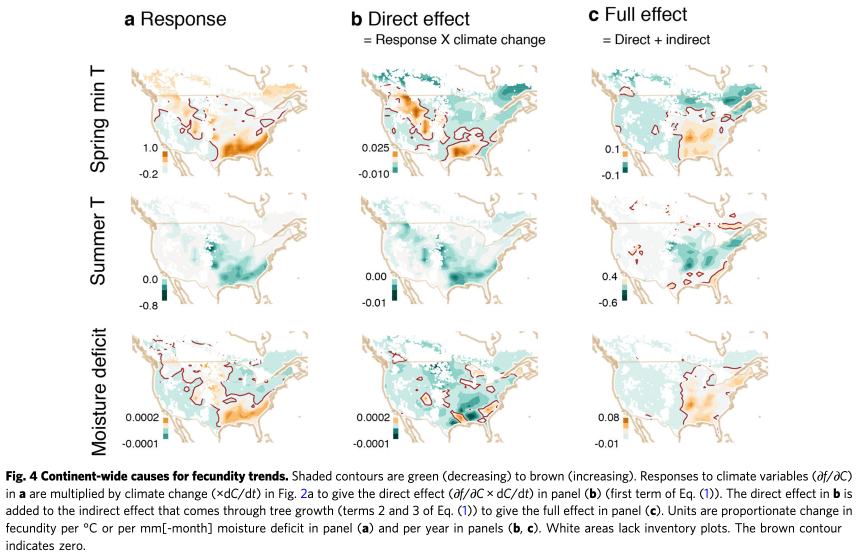Lane Scher on predation by house cats
Duke University Opinion and Analysis: Domestic cats kill more than 2 billion birds each year, making them one of the largest human-caused threats to birds [read more]
Duke University Opinion and Analysis: Domestic cats kill more than 2 billion birds each year, making them one of the largest human-caused threats to birds [read more]
Michał has obtained a 24-month Research Fellowship from the Bekker Program to join the INRAE group at Université Grenoble Alpes on MASTIF. He will work with Georges Kunstler, Benoit Courbaud, Valentin Journe, and Jim Clark on masting pattern and process.
Michal’s web site is here.
Becky Tang’s new paper shows how to improve estimates of distribution and abundance from ebird data by accounting for spatial bias in observation effort. Her paper received the Best Award from the Department of Statistical Science.
Tang, B., J. S. Clark, and A. E. Gelfand. 2021. Modeling spatially biased citizen science effort through the eBird database. Environmental and Ecological Statistics, https://doi.org/10.1007/s10651-021-00508-1.


The Best Award is given annually from the Department of Statistical Science, Duke University. Becky is recognized for her paper, “Modeling spatially biased citizen science effort through the eBird database” to appear in Environmental and Ecological Statistics
Kai Zhu is a former PhD student in the lab. The Ecological Society of America’s recognition is “based on his blending of classical ecological theories with modern computational tools to study global issues like climate change.” Read more.
Maggie for her research on drought impacts on wildlife in Kruger National Park and Renata for her urban forestry research. Of 2000 awards nationally this year, Renata and Maggie were among 18 fellowships awarded to Duke students. Announcement here.


Maggie Swift: “An analysis of an African savanna community’s resilience to changing climate, water distribution, and management practices.”
Renata Poulton Kamakura: “Tree species growth and diversity in city forests and the implications for urban biodiversity conservation“
The Editor’s Highlights selected the first MASTIF (Masting Inference and Forecasting) publication for this week’s recognition. The paper is here.
Additional coverage is here.
Coverage focus on Gilbert and Zhu’s coast redwood site is here.
The NatureNet Science Fellowship comes with salary, benefits, travel, and research funds. It will support Renata’s research on managing urban environments with rapid climate change.
The composition and structure of twenty-first century forests will depend on the seed production needed for tree populations to keep pace with climate change… [read more]
Greenwire: Climate change altering how trees produce seeds
Climate feedbacks drive east-west divide in forest seed production

This year, local birdwatchers are pleased to find that more northern birds are making their way farther south to make North Carolina their winter home… Lane Scher on evening grosbeaks in Durham

We teamed up with Roland Kays at North Carolina State University to generate a youtube channel for the data used in our biodiversity analysis. Each is a field demonstration by a different student or postdoc in the lab. These videos are being linked to the iNaturalist mastif project (Masting Inference and Forecasting) and vignettes that can be used for class. The video channel is here.
Supported by the National Science Foundation grant DEB-1754443
A collaborative effort centered in the Clark lab at Duke University is recruiting a Postdoctoral Associate in quantitative microbial dynamics. The position is funded by the National Science Foundation to evaluate the direct and indirect effects of environmental change on microbial dynamics. The goals of the study… [read more]
We are delighted to announce the winners of the 2019 New Phytologist Tansley Medal for Excellence in Plant Science, read more…
Predicting how ecological communities respond to change requires an understanding of the direct effects of environment and the indirect effects that emerge when environment is propagated through food webs of interacting species. A probabilistic framework for these environment–species interactions can guide management that has to weigh the utility of efforts to protect critical habitat (or not) against the risk for species that respond through the responses of others. [read more]
Clark, J. S., C. L. Scher, and M. Swift. 2020. The emergent interactions that govern biodiversity change. Proceedings of the National Academy of Sciences, 202003852, https://doi.org/10.1073/pnas.2003852117. clarkPNAS2003852117.full
In September 2016, over 375 members of the U.S. National Academy of Sciences (NAS) signed an Open Letter calling attention to the dangers of human-induced climate change. The letter warned that U.S. withdrawal from the Paris climate accord would have negative consequences for the world’s climate system and for U.S. leadership and credibility. more…
The Yellow-billed Cuckoo has soft brown wings, a white belly, a long tail with black and white spots, and is running out of places to live. The cuckoo’s population in its native breeding range in the eastern United States has declined in recent decades due to urbanization, heat waves and other factors. Climate change will likely further reduce its suitable habitat. [read more…]
Mary Lou Williams Center for Black Culture, Duke University
Graduate Student of the Year: honored for their outstanding work in specific Graduate/Professional Schools and for their commitment to Black communities and Black scholarship.
Zaire McPhearson (MFA, Graduate School)
Kirsten Simmons (Medical & Divinity School)
Jakaela Davis (Divinity School)
Nathaniel S. Neptune (Medical School)
Dionna Gamble (Medical School)
Nicholas Hastings (Medical School)
Jewel Scott (School of Nursing)
Morine Cebert (School of Nursing)
Renata Poulton Kamakura (Nicholas School)
Danielle Bembry (Law School)
Graduate & Professional “Willing and Abele” Student of the Year goes to a graduate student that has demonstrated an intangible quality which uplifts the Black community and is engaged in various leadership and/or civic activities on campus or in the Durham community. This individual demonstrates vision, dedication, academic excellence and has excelled at communicating and motivating others to rally around their cause. This student of the year will have made a continuous and inspiring impact and will be held in high regard by his or her peers.
Chavis Jones, (Law School)
Morine Cebert (School of Nursing)
Jewel Scott (School of Nursing)
Renata Poulton Kamakura (Nicholas School of the Environment)
Rheaya Willis (School of Medicine)
Gwenaelle Thomas (Neurobiology)
Kirsten Simmons (School of Medicine)
For his project quantifying the effects of climate variation on tree fecundity in the Alps, Ethan Ready has been awarded Graduation with Distinction in the Environmental Science major.
Rising temperatures with increased drought pose two challenges for management of future biodiversity. First, are the most vulnerable species concentrated in specific regions and habitats? Second, where can landscape heterogeneity potentially mitigate impacts? We conducted a comprehensive trait analysis of forest plots spanning the eastern United States to quantify how resource‐acquisitive species respond to moisture‐soil‐climate interactions. We found that resource‐acquisitive species, including nutrient‐acquisitive and moisture‐acquisitive species, respond disproportionately to environmental gradients, and their response is largely explained by soil variation. We showed that the strong boundary of resource‐acquisitive species occurs near the last glacial limit, highlighting one of the clearest indicators of soil controls. Although local soil moisture may reduce drought‐induced stress for moisture‐acquisitive species, nutrient‐acquisitive species remain vulnerable on wet soils in dry climates. The results suggest that theories explaining species distributions should devote close attention to the combination of local drainage and soil type. [read more]